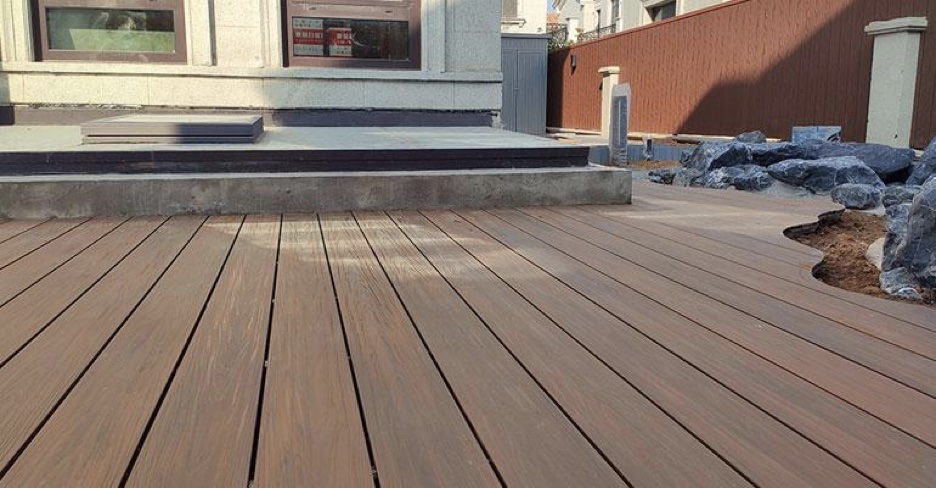Wood decking used to be the accepted material for building a deck, but that is no longer the case. As a result of homeowners’ exploration and acceptance of various materials, there are now a greater variety of alternative decking materials available.
Since there are now more options for deck surfaces, homeowners must do a little more research on the benefits and drawbacks to take into account before selecting a decking material. You must examine a variety of factors when choosing the best hardwood decking substitute, including upfront expenses, upkeep needs, durability requirements, and more.
Composite decking
A combination of plastic and wood is used in composite decking. Although composite decking and wood decking have many similarities and a variety of color and personalization options, there are also many differences that buyers should be aware of.
Composite decking first appears to be more expensive than wood decking since the installation fee ranges from $30 to $60 per square foot. However, the reduced maintenance needs of the composite can offset those expenses and, in the long run, save you more money and time.

Pros
- Excellent Durability
- Utilizes recycled materials
- Low maintenance
- Stain-resistant
- Long warranty
Cons
- Bowing or sagging may occur if installed incorrectly
- Higher upfront cost than wood
- Can’t be painted
- Some brands are better at imitating wood than others
PVC Decking
Despite the fact that PVC decking is fully comprised of synthetic thermoplastic, people occasionally mistakenly confuse polyvinyl chloride (PVC) and composite. It resists tiny dents and scratches remarkably well, which are more easily accumulated on other materials. This material is reasonably affordable and straightforward to recycle. PVC typically costs between $5 and $13 per square foot.
Pros
- Won’t rot, rust, or fall prey to an infestation
- Durable and easy to install
- Plenty of color and style options
Cons
- Direct sun exposure can lead to fading
- Can become brittle over time if used in areas with cold weather seasons or temperature fluctuations
- Doesn’t last as long as wood
- Will bow or warp with age
Decking made of aluminum
One of the less popular alternatives to timber decking is aluminum decking, but it’s still a great choice to take into account. It is often constructed from recycled aluminum, finished or colored, and then given a waterproof coating. As a fully recyclable material, aluminum decking typically costs between $15 and $35 per square foot.
Pros
- Immune to rot, rust, mold, and other infestations
- Requires minimal maintenance
- Long-lasting
Cons
- Aluminum surfaces can be noisy unless you pay for special high grade-materials treated to reduce noise
- Can be more challenging to locate local aluminum decking sales options
- Not a passable imitation for wood; comparably fewer style options
- Can be more difficult to install than wood decking
Bamboo deck
Although it is a form of dried grass, bamboo resembles wood in many ways. As a result, bamboo typically performs well in the same circumstances as wood. Because woven bamboo strands are stronger than non-woven, they may affect how long a deck lasts. When kept properly, it can last about as long as wood and has similar maintenance requirements. Where it is accessible, bamboo decking typically costs between $9 and $11 per square foot.
Pros
- Resilient, lightweight, durable; easy to work with
- Minimal expansion and contraction of the material in extreme weather
- The natural beauty is similar to wood
Cons
- Shares wood’s vulnerabilities to mold, mildew, rot
- Appearance fades over time, similar to wood
- Requires regular maintenance, sealing, staining, etc.
Tiles made of rubber
High-density rubber with a unique micro-porous surface, used to make rubber pavers, is not different from the substance found in car tires. Pavers are almost impervious to problems with water, mold, and discoloration. Rubber paver tiles typically cost $3 to $5 per square foot, but they have numerous distinct advantages.
Pros
- Water-resistant, remarkably durable
- Not slippery while wet
- The elasticity of the material makes it comfortable underfoot
- Interlocking design that’s easy to install
Cons
- Many solvents are inappropriate for cleaning rubber
- The ground may need to be trimmed or leveled before installation, or unevenness can occur
Deck Tiles That Interlock
Stone and wood are two examples of the many types of materials that may be used to create interlocking deck tiles. Building with large deck tiles is like putting together a huge puzzle, which also makes it simple to redo an old surface. Convenience isn’t free, though; the average cost per square foot ranges from $17 to $50. Non-wood deck tiles typically cost $35 per square foot on average.
Pros
- Makes use of the natural beauty of wood, stone, or other materials
- Numerous ways to customize and personalize tile patterns, easy to install
- Simple to replace damaged tiles
- Can be used to cover existing decking
Cons
- Can be considerably more expensive than most alternatives to wooden decking
- If you’re not replacing existing decking, it might be necessary to establish a foundation
There are several alternatives to wood that you may consider if you want to look into deck material options. Consider the advantages and disadvantages of each material and conduct research to determine which is best for you.
Interesting Related Article: “In general, how long does it take to tile a bathroom?“
